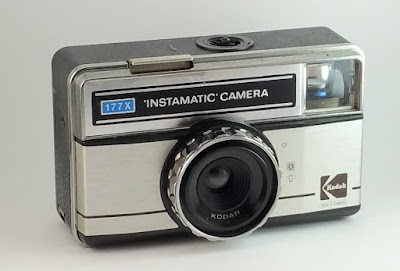 |
| Kodak Instamatic 177X (1977-1984) |
#105
Esta fotografia é do exemplar que possuoCaracterísticas
Instamatic was Kodak's trademark name for their easy-load 126 cartridge film cameras, launched in February 1963 with the Instamatic 50. Later, in 1972 Kodak used the name Pocket Instamatic for some of their 110 cartridge cameras; other 110 models were branded Ektra or Ektralite, and for Super8 8mm movie cameras and projectors. Kodak 126 Instamatics were a great success and sold around 60 million by 1976; thus "Instamatic" became a generic term for cartridge-loading - or any plain point-and-shoot - cameras, irrespective of manufacturer.
Frequently "Instamatic" was used in error to refer to Kodak's instant cameras. Due to the strong association of Instamatic with 126 cameras, the name was not used for Instant cameras, which were instead branded Kodamatic, Colorburst, EK or simply Kodak Instant.
Fonte: Camerapedia
Especificações
Instamatic cameras were manufactured in various plants across the world, in particular by Kodak in the US, by Kodak AG in Germany, and by Kodak Ltd in the UK. Kodak. SA Spain. Instamatic models continued until c.1988.
Whilst most Instamatics were simple "snapshot" cameras, made of plastic with very few, or no, adjustments, the range extended through designs with metal chassis, light meters or automatic exposure, rangefinders and even an SLR with interchangeable lenses. There were also add-ons such as teleconverter lenses, viewfinders etc.
Early Instamatics (e.g. Instamatic 50) had a special flash adaptor for either AG-1 bulbs or (later) Flashcubes; a few had a pop-up flash gun. Later models used Flashcubes or ("X" models) Magicubes without an adaptor. From 1975, 126 and 110 models were introduced to use the new Flipflash system.
Model numbers ending in 0 have pop-up flash gun; ending in 4 have Flashcube socket, ending in X have Magicube socket. Models ending in F have Flipflash.
Fonte: Camerapedia
Until the introduction of the "Kodapak" cartridge in 1963, with it's associated "Instamatic" brand-name, cameras aimed at the consumer market were almost universally roll-film models, with all the inherent problems of loading that that type of film incurs. Now members of the public could load their own cameras with no risk of fogging the film. When the Instamatics were introduced Kodak also released Kodacolor-X for colour prints, and Kodachrome-X and Ektachrome-X for slides. With the improved performance of the new colour emulsions, all three films could be used at the same setting as the then-popular Verichrome Pan black & white film, all of which were available in 126 cartridge. The first Instamatic to be marketed was the Instamatic 50, on sale in the UK some weeks before the Instamatic 100 was launched in the USA. The Kodapak cartridge featured automatic film-speed sensing, a feature possibly first seen on the Agfa Rapid system, and now common-place, with the introduction of DX-coding of 35mm cassettes.
The concept was an immediate success, with more than 50 million Instamatic Cameras produced by 1970. Kodak produced these cameras until 1985 in Europe with the 277X, until 1988 in the USA, the last model there being the X-15F, according to Kodak's on-line Customer Service Pamphlet AA-13, though it would appear that Instamatic 126 cameras were still being produced by Kodak in Brazil in the mid-1990's. The term Instamatic went into general usage to describe any easy-to-use basic camera, which rather detracts from a range that included an interchangeable-lens SLR, several range-finder cameras, and many with top-quality lenses from the likes of Rodenstock and Schneider-Kreuznach, as well as Kodak's own renowned Ektar. Whilst the bulk of production was no doubt from Rochester in the USA, and Germany and England in Europe, cameras were also manufactured or assembled in Spain, Brazil, Argentina, Australia and Canada, mostly for domestic sales. In Brazil, the Kodak Instamatic was apparently considered to be something of a luxury item, consequently a local manufacturer came up with the Tekinha Camaras, a minimalist option.
Brightline viewfinder and sunny/cloudy exposure settings. This example was manufactured in the UK, but I have been made aware of similar "camaras" being produced in Brazil.
Name : Kodak Instamatic 177X
Produced between : 1977 - 1984
Lens : f/11, 43mm
Shutter : 1/40, 1/80
Film type : 126 cartridge
Picture size : 28 x 28 mm
Categories : instamatic
Modelo
Instamatic 177X were made in UK, Germany and Argentina, from Jan 1977 to 1984.
Fonte: Camerapedia
A minha foi fabricada em Inglaterra.
Sítios de referência
Camerapedia
Kodak Classics
Manual
Filme
Fotografias tiradas com esta máquina
Vídeos
Sem comentários:
Enviar um comentário